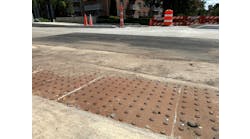The Michigan Department of Transportation (MDOT) recently deployed the nation’s first Truck Parking Information & Management System (TPIMS) at five public rest areas and 10 private truck stops along a section of I-94 from about 1.5 miles south of the Indiana border to east of I-69, near mile marker 128.
The system measures parking availability at both public and private lots along the corridor and distributes the information via dynamic truck-parking signs, a mobile phone application, a private website, MDOT’s MI Drive traveler information website and connected-vehicle technology. Developers are hoping the unique and innovative solution will be a model for other DOTs and toll authorities to develop a multistate-corridor approach to providing timely, reliable truck parking information.
When truck driver Jason Rivenburg pulled his rig into an abandoned gas station on March 9, 2009, he was looking for a safe place to rest. What he found was a robber who shot and killed him for the $7 he had in his pocket. Rivenburg left behind a 2-year-old son, a pregnant wife who would give birth to twins 13 days later and a load of milk for a retailer that would not allow trucks to show up on-site early for deliveries. He was only 12 miles from his destination.
Rivenburg was murdered off of I-26 in South Carolina, but his plight exemplifies a national problem that is only getting worse as traffic volumes increase, budgets tighten and public rest areas prove inadequate to accommodate all of the truckers on the road. There simply are not enough safe places for truck drivers to park along the nation’s highways, or at least, truck drivers do not know where to find available spaces.
Commercial truck drivers routinely spend at least 15 minutes—from the time they either decide or are federally mandated to take a break—looking for a place to park, according to a 2013 survey led by a nonprofit coalition that includes Rivenburg’s widow, Hope Rivenburg. Nearly 40% of the 3,996 truck-driver survey respondents indicated they routinely take an hour or more to find parking. A whopping 88% of the respondents indicated they do not feel safe while parked during a mandatory rest period or while waiting to pick up or drop off a load.
Truck drivers are often forced to park on highway shoulders and exit ramps, or in abandoned gas stations and commercial parking lots, exposing themselves and the traveling public to hazards.
Additionally, the time it takes them to look for safe parking could be spent driving and furthering their loads to final destinations. That is a huge economic expenditure in wasted time and miles. It also is a huge environmental issue, considering how much diesel emissions these trucks are spewing while the drivers search for parking.
In October 2010, the Federal Highway Administration (FHWA) issued a notice of funding availability from the Truck Parking Facilities Program, paving the way for MDOT’s Intelligent Transportation Systems Program Office to submit a proposal for the TPIMS pilot project. MDOT submitted its proposal with a letter of support from the Great Lakes Regional Transportation Operations Coalition. In 2011, the FHWA awarded MDOT $4.48 million to implement a TPIMS along the I-94 corridor.
Well-traveled trade route
The chosen project area of I-94 is part of the east-west corridor that connects the country’s Great Lakes and Intermountain regions. It is the pathway for commerce traveling between Chicago, Detroit, Toronto and destinations beyond. Truck volumes and concentrations on the corridor are incredibly high: 30%, or about 10,000 trucks per day. Yet, the five public rest areas in that 129-mile project segment have a maximum truck parking capacity of only 158 spaces.
On average, one truck crash is reported every day within the project segment. Between Aug. 1, 2007, and July 31, 2010, a total of 5,825 crashes were reported along that stretch. Of those, 1,085, or 18.63%, involved trucks.
The ability to disseminate truck-parking availability information effectively to commercial-vehicle operators allows them to more effectively plan for parking activities, both pretrip and en route, which decreases the potential for driver fatigue and unsafe parking decisions. The system will improve the safety of the truckers and, potentially, decrease the number of motorist crashes associated with truck-driver fatigue and unsafe truck-parking decisions.
HNTB was selected by MDOT in April 2012 to plan, design and help administer the TPIMS during construction. MDOT wanted a system that would be reliable, scalable and sustainable. It had to be a system that truck drivers would use routinely, could be expanded to other corridors without rework and would not require substantial, perpetual government subsidy.
Your safe harbor is ready
MDOT and HNTB identified more than 1,000 parking spaces in private truck stops adjacent to the corridor that were being underutilized. The plan was to somehow bring those into the equation with the 158 available public rest-area spaces in the project area and devise a system to inform drivers to all parking availability.
The initial challenge was to collect accurate real-time data of parking availability. HNTB evaluated side-fire radar detection, in-ground magnetometers and video surveillance/detection equipment to collect the data from both public rest areas and private truck stops. Once planning began, it became obvious that private companies were experiencing something of a Big Brother perception and were not going to allow a public agency to install sensors on their property. Additionally, there was not a clear path how MDOT would secure contract rights to work on private property.
Truck volumes on the corridor are 30%, or about 10,000 trucks per day. Yet, the five public rest areas in that 129-mile project segment have a capacity of only 158 spaces.
HNTB’s solution was to develop a business-to-business relationship with the private truck stops along the corridor, wherein HNTB was allowed to install detection cameras and collect data and then license that data to MDOT. To make that possible, MDOT revised HNTB’s contract to a sustainable public-private partnership in early 2013.
Sail trimming
Normally, video surveillance/detection equipment of this type is deployed on highways where consistent speeds exist in well-defined lanes, making counting cars fairly simple. However, these cameras were placed at driveways where trucks are in turning moves, stopping and starting. HNTB worked closely with the manufacturer, Citilog, and their engineering support to devise a way to fine-tune the technology.
When detecting at driveways, consistent detection between driveways proved as important as accurate detection. For example, the system will behave better if each driveway over-counts by 5%, as opposed to one driveway over-counting by 2% and another under-counting by 1%. The ability to calibrate equipment is key to success with an in-out detection system. To accommodate this, the project team built adjustable variables within the calculation algorithms and installed surveillance cameras at each facility to allow for manual availability counts and correction of the system as necessary.
The TPIMS incorporates dynamic truck-parking signs, 5.9-GHz dedicated short-range communications for a connected-vehicle system and the integration of the new system with MDOT’s existing Advanced Traffic Management System software.
None of the technologies is unique. They have simply not been integrated for this particular application.
The TPIMS incorporates dynamic truck-parking signs and 5.9-GHz dedicated short-range communications for a connected-vehicle system.
As the data is collected from the detection cameras or other sensors at MDOT rest areas or private truck stops, it is fed through the Internet to Truck Smart Parking Services (TSPS), a private data-acquisition company that already distributes dynamic parking availability information via the Internet. TSPS shares its private-truck-stop data with MDOT, and MDOT shares public-rest-area data with TSPS. That way, all involved parties have a full set of data for all 15 parking areas in the pilot project. TSPS then transmits the data through its website and free iPhone application. MDOT transmits the data through its MI Drive website, dynamic truck parking signs and the connected-vehicle system Kapsch TrafficCom developed as part of the project.
Additionally, nine vehicles from Jim Burg Trucking Co. in Warren, Mich., were equipped with the connected-vehicle system so drivers can receive information directly in the cab. This pilot application will prove the usefulness of this traveler information within connected-vehicle applications, as well as the value of parking data integrated with existing onboard systems.
Pilot application
Again, none of these individual technologies is new. However, previous traffic detection efforts focused on advancing technologies and determining the most accurate technology systems. The key difference with the I-94 TPIMS was the development of a more holistic approach with overall system reliability.
The TPIMS went online at six private truck stops on April 1, 2014, operated and maintained by HNTB and TSPS. The remaining four private truck stops and the five public rest areas were operational in June 2014.
While the project operation is in its infancy, reaction from the industry has been encouraging. In addition to reducing illegal truck parking and safety concerns along the corridor, the project team expects the system will increase efficiencies within the trucking community.
The 2013 survey previously mentioned revealed that a large percentage of truck drivers stop driving their appointed route earlier than federally required because they are concerned about their ability to find a place to stop safely. If the time spent searching for parking could be reduced, the industry could gain efficiencies from both an operational and fuel-savings perspective. With nearly 400,000 daily truck parking events across the U.S., saving an average of 15 minutes per event equates to an annual operational savings of $4.4 billion. That does not include calculations of reduced environmental impacts or increased productivity from more efficient trips.
Expanding ripples
HNTB is contracted to operate the data collection sensors at the 10 private locations for 19 months, while MDOT operates the five public rest areas. During that time, the University of Michigan Transportation Research Institute (UMTRI), a world-renowned research institution in the area of traffic and transportation, will assess the reliability of the system and the multiple information dissemination methods.
UMTRI will evaluate the accuracy of the technology and level of manual calibration needed, as well as the overall effectiveness of the data dissemination in decision making. Ideally, from a business standpoint, the system will require little or no intervention in order to be sustainable.
In order to maximize the effectiveness of the system, ultimately, it must be applied to multiple corridors in multiple states. Truck stops, independent truckers, truck fleet operators, other DOTs and toll authorities are closely watching this pilot project. The project team’s goal is to show that it can work and to get other agencies in other states—in both the private and public sectors—to see the value of the system so it will expand beyond Michigan.
In honor of her husband and for the safety of all truck drivers, Hope Rivenburg spearheaded an effort to improve safe truck-parking options through: new construction of parking facilities; reuse of existing inspection, weigh station and park-and-ride facilities; and other capital improvements. President Obama signed into law what became known as Jason’s Law on July 6, 2012, as part of the Moving Ahead for Progress in the 21st Century Act. Hopefully, other states may soon have funding for similar TPIMSs. TM&E



